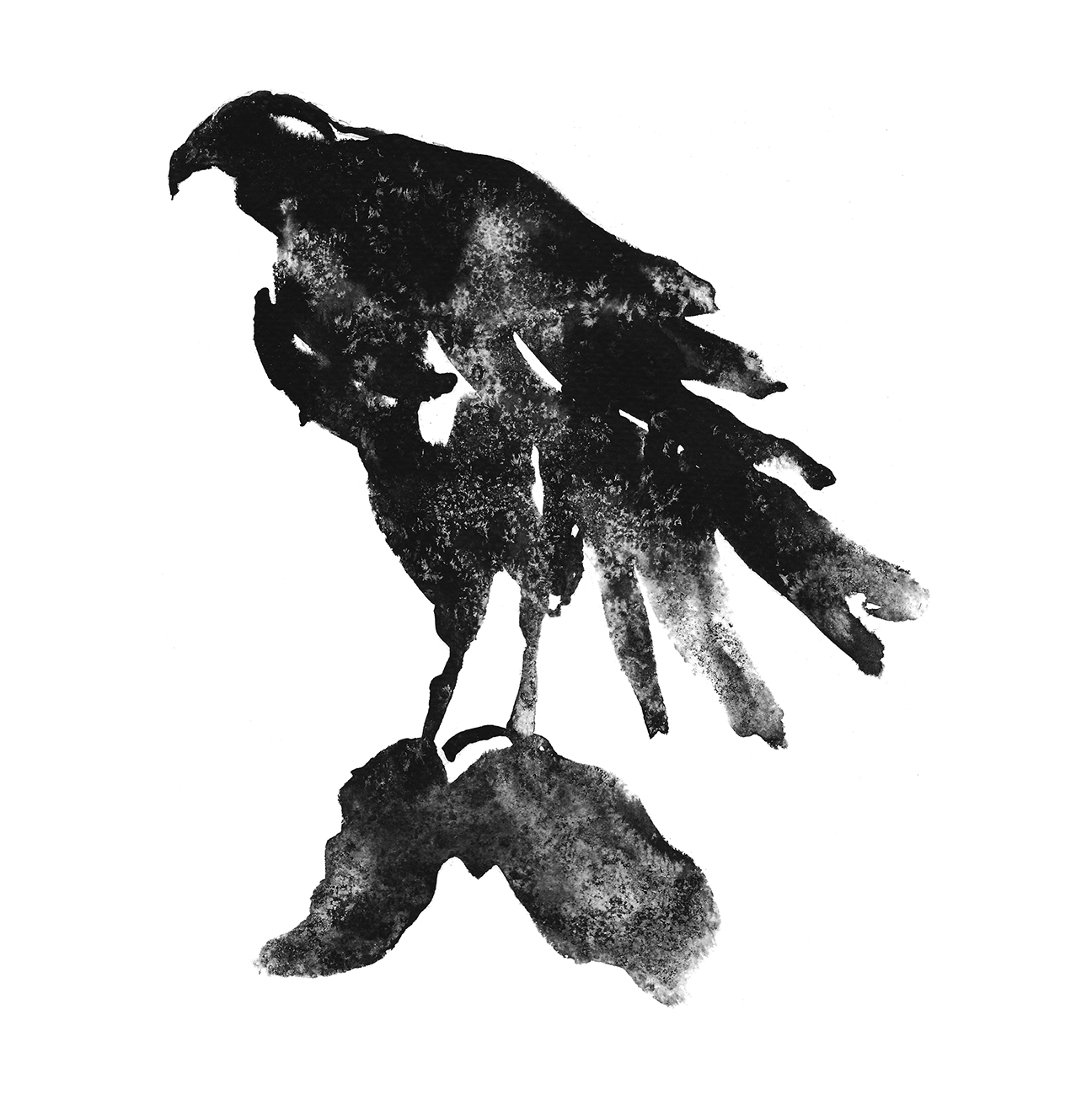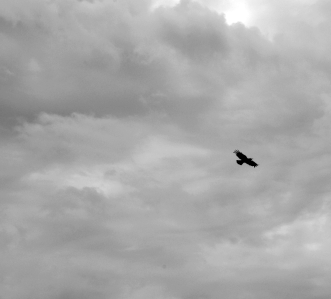I have a small but growing collection of bird skulls, mostly found on walks in the woods or on cliff-top paths. My favourite is from a manx shearwater. I found it on a clifftop path on Skomer Island, which is home to a hundred thousand of these seabirds in the summer. They are a favourite prey of gulls, and the island is littered with their bodies. The remains of a recently predated manx shearwater look like the smoke-blackened wings of an angel. The head, torso and legs are consumed, leaving only a section of spinal column still attached to the two coracoids, scapulas and untouched wings. A skull is a rarer find and mine is precious to me, a miraculous craftwork, delicate as a sculpture made from slivers of ice. When I hold it, it feels like it will melt in my hands.
I also own a few rook skulls. I don’t know at what interval in time the common ancestor of the manx shearwater and the rook existed, or the great distances that both species had to travel to arrive at their contemporary forms, but when comparing their skulls it doesn’t seem like the journey was so great. Though the rook skull is much larger, the profiles and proportions are similar, the main difference being the way the beaks are shaped towards their tips, the rook’s making a gentle downward curve and the manx shearwater’s a talon-like hook.
You can understand the miracle of flight better by holding a bird’s skull than its wings. The skull seems almost impossibly light, as if wings aren’t required to get such a weightless thing airborne. A breath of wind will surely be enough. For a bird, the wiring for consciousness is contained in the most delicate shell. If the bone was twice as thick would the bird be able to fly?
The manx shearwater is an exotic, an almost never-seen being inhabiting the edges of our landscape for a short time before travelling to the other side of the world. The rook, on the other hand, is a commoner, an always-there, particularly in my life. My bedroom window overlooks a stand of oaks hosting a rookery, which at this time of year is occupied by a couple of hundred birds. My workplace, in the centre of a town, is fifty metres from three plane trees which are now the home of an increasing population of the corvids.
While I’m writing this I’m glancing out of the window every few minutes, keeping an eye on them. One or two take off and fly a loop around the trees. I’m hoping that they’ll all spray up into the air together so I can watch the flock tumble and dive. But they know I’m watching, so it’s unlikely.
One of the root meanings of the word common is to move together. Nothing could describe rooks better. They are the ultimate commoners. Which isn’t to say that they are lowly. For me, they are great acrobats and artists. The way a flock spirals and dives, the small sub-groups creating their own shapes within the whole movement, the individual clowning and dare-devilry, effortlessness and sense of joy. The fact that they fly to go nowhere at all. The naked-nosed crow, as it is known in China and Japan, is utterly extraordinary, despite its monotone, tatter-cloaked form.
The monk ryokan wore a tattered black robe for most of his adult life. He left the monastery after his training and became a hermit. He lived in a single room hut with almost no possessions and survived by begging, the lowliest of individuals. He was also a great poet and calligraphist in a culture where calligraphy was seen as the highest of all art forms. For much of his life he could not afford brush and paper. He practised and achieved mastery by drawing in the air with a finger. When great men came to request a poem for their homes, he mostly refused (or simply wrote 1, 2, 3, 4) and sent them on their way. But when a little girl once approached him on the street with a sheet of paper, he took it and asked what she wanted to use it for. She told him she was going to make a kite. He wrote, sky above, great wind, in calligraphy that amazes modern scholars with its skill and effortless expression. He loved the company of children and there are accounts of him playing hide and seek in the fields, the old monk hiding for a whole day buried in a hay stack. He was a fool and a master, the lowliest and the loftiest. When I read his work I think of rooks.
Showing its back
and showing its front
a falling maple leaf
Ryokan rejected the path of the monk because traditional buddhist detachment was too attached for him. He did not want to partake in monasterial life, carrying out daily duties and rituals. He decided he could serve life better by not serving it at all. Samuel Beckett made a similar decision early in his career when he turned down a future as an academic and teacher, saying that he had absolutely nothing to teach. Ryokan’s doubt even extended to his poems, perhaps to poetry itself.
Who says my poems are poems?
My poems are not poems.
When you know that my poems are not poems,
then we can speak of poetry!
I’ve spent a few evenings lately glancing through samples of the literature of self-improvement. There are books about billionaires and super-athletes, about how to build great businesses by creating successful habits, by sustaining self-belief and optimism. They urge us to hack time. Do – that is the secret of success. Be useful. I doubt if any of these thinkers think that a day spent hiding in a hay stack is a good use of time. They certainly would never encourage us to be a beggar. Or a rook.
Autumn is here. Through the open window I can see a leaf just detached from its branch. It hasn’t fallen. Instead it has caught on the strand of a cobweb. Now it twists and spins continually in a breeze so light I cannot feel it at all. It reminds me of a great poem, like W.S. Merwin’s Rainlight, made from a few simple images and breath. The most beautiful things are the ones that are almost impossibly present, or the things that are almost not there.
I have no idea about the usefulness of rooks, or the reason for their wild flocking above the trees. Biologists would probably conclude that their purpose is to keep insect numbers down. They would maintain that birds fly together to cement a social bond, or that their survival depends on their acting as a single entity, a super-organism creating a difficult target for predators. It makes sense, but I doubt Ryokan would have agreed. Rooks flock because they flock, would have been his answer.
He would have known that the purpose of rooks is to teach the rest of us creatures detachment, from our duties, our ambitions, our selves. It’s the only way for us to grow wings.
Tomorrow
I will fly away
to who knows where,
as someone has made me
a (naked-nosed) crow
Translations of Ryokan’s poems come from the wonderful book – Sky Above, Great Wind. The Life and Poetry of Zen Master Ryokan, by Kazuaki Tanahashi.

